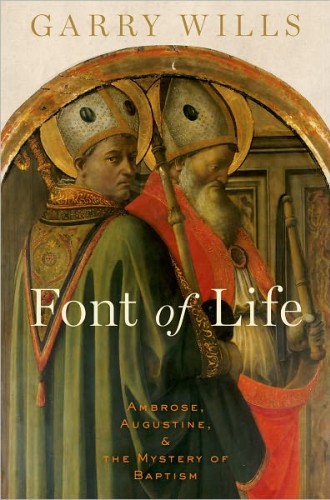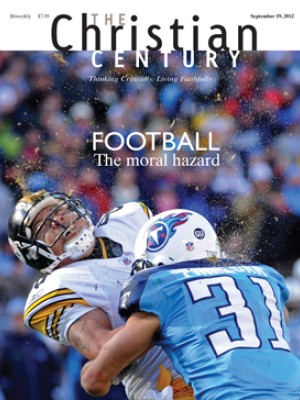Font of Life, by Garry Wills
A story is told of Anglican Bishop Desmond Tutu in Cape Town, South Africa. He ascended the cathedral pulpit one Sunday to preach, yet again, against the evils of apartheid. As he did so, government-dispatched soldiers with machine guns encircled the nave. The tenseness of the moment indicated that if the bishop dared to speak against government policy, there would be a violent assault on him by the soldiers. When the bishop surveyed the scene from the pulpit, he paused, and then he laughed. Slowly members of the congregation laughed with him. And finally, the soldiers also began to laugh. All laughed together, I suppose, at the absurdity of the scene. When the laughter subsided, Tutu preached yet again against the evils of apartheid. And the soldiers, along with the congregation, listened respectfully.
Garry Wills presents Ambrose, the powerful bishop of Milan in the fourth century, as a recognizable forerunner of Tutu, for he too weighed in against government authority when he saw the government intruding upon the claims of the church over which he presided. Indeed, in his contest with the emperor,
Read our latest issue or browse back issues.
believers were harassed as they went into or came out of Ambrose’s services in his various churches. Late in the year Ambrose preached with soldiers all around the church he was in, and he praised those present for their courage in coming under such intimidation.
Where Tutu laughed, Ambrose sang, and “he kept up the defiant singing he had used to build morale against the foe.” The congregation joined him, “keeping up their spirits in song.” In the end, Ambrose found support even among the imperial troops:
The loud devotions being carried on just outside the Basilica Nova drew some curious soldiers over to the twin church next door. Their entry frightened the community, but the soldiers protested that they were just there to join in the prayers.
Font of Life is an interesting and evocative addition to Wills’s impressive corpus. Wills has a gift for taking up a subject afresh, probing it deeply with help from scholars in the field (in this case especially Peter Brown), and presenting his findings with clarity and hints at the contemporaneous relevance of his research. Here the lead figure is Ambrose, though the story eventually concerns the relationship between Ambrose and Augustine, along with the pivot poin of Augustine’s baptism. It is a study of the way in which the historical-political-cultural context tugs at both theological interpretation and church practice. Such a study, of course, deabsolutizes theological-liturgical claims and may lead readers to an awareness of the contextuality of their own claims.
In leisurely fashion Wills sketches out the territory of Milan and Ambrose’s character and his role in the century of the church’s great doctrinal formulations. He provides summary data concerning the baptistry in the Milan cathedral and the high drama of the day in 387 when Ambrose baptized the 48-year-old Augustine. We are invited to view the architecture and artistry of the baptistry, to hear the baptismal instruction in its rigor and to consider the liturgical processes of refusing Satan, of being anointed with oil “all over their bodies like athletes,” and of unclothing and reclothing for newness of life.
The regime of Ambrose provided programmatic accents that have endured in Western Christendom:
The church would learn to act according to Ambrose’s ruling patterns—his development of doctrinal rigor (especially on the Nicene Creed), the centrality of baptism, liturgical expansiveness, monastic discipline, the cult of saints, and episcopal control.
The convergence of all of these factors, with aggressive enforcement, created an office and authority that established the dominant narrative of Western culture and made high claims for the church to be the guardian and maintainer of that narrative. The interface of doctrinal rigor and episcopal control (from which Ambrose did not flinch) was certain to bring the bishop into collision with imperial authority. The contest was made more urgent by the fact that imperial authority was an off-and-on champion of Arianism, against which Ambrose stood with passion.
Wills focuses on two marks of Ambrose that mattered to his role in church and empire. First, by happenstance or by deep spiritual blessedness, Ambrose presided over the recovery of the remains of two martyrs, Gervase and Protase. This discovery greatly abetted Ambrose’s authority by placing him visibly in the company of the martyrs. Second and more important were the methods whereby Ambrose interpreted the Old Testament in typological ways that “saved” the Old Testament for gospel faith. In this reading, Isaac is “the type for Christ,” Jacob is a model of faith in adversity, and Joseph is a model of chastity. (Samples of Ambrose’s exegesis are offered in Robert Wilken’s Isaiah, a commentary in the Eerdmans Church’s Bible series.) This perspective, from which Augustine learned, helped to open positive attitudes toward Jews, for the material for such reading was given in and by Judaism.
Augustine comes late into Wills’s purview. At the outset he was a not very important functionary of the empire in Milan who initially had a negative view of the way in which Ambrose related to the empire. Although Ambrose did baptize Augustine, Wills sides with those who judge that Augustine was not initially converted by Ambrose.
Eventually the book concerns “the font”: the act and meaning of baptism. Wills explores the form and function of the liturgy of baptism, with an accent on the unity of the church, the work of the Spirit and rigorous instruction based on the typological exegesis. He judges that Ambrose, in response to the crisis of Arianism, was a “sacramental maximalist” who regarded “baptism as the culmination of the entire sacred history leading up to Jesus’s fulfillment of all the prophecies that pointed directly to baptism.” By contrast, Augustine, shaped by his struggle with the Donatists and the Pelagians, was a sacramental “minimalist” who paid less heed to the “mystery” of baptism and gave more attention to the “legalistic, almost mechanical” aspects of it, being more concerned with continued growth and discipline in the faith.
The contrast Wills draws is an important one, suggesting a pluralism and a contextualism that have been much neglected. In common practice, Augustine’s view prevails. But Wills’s last chapter is titled “Augustine Needs Ambrose.” When he became a bishop, Augustine came to a greater appreciation of Ambrose, his exercise of authority and his capacity to hold together worldly power and theological articulation. Whereas Augustine emphasized “inwardness and study,” Ambrose is noted for his “forcefulness” and his readiness to mobilize authority for the sake of sustaining the church.
It would be interesting and instructive for Wills, who has written about the contemporary Catholic Church, to ponder parallels between those very strong bishops in the fourth century and the strong bishops who now govern the church. For Augustine and Ambrose in their context, the championing of “truth” was urgent. Ours is a time when we live with a rigorous absolutism alongside a trivializing accommodation in which anything goes. These fearsome fourth-century characters, defiant as they were, agreed that the claims made in the sacraments were urgent claims, especially in the face of imperial ideology and its accompanying theological propensities.






